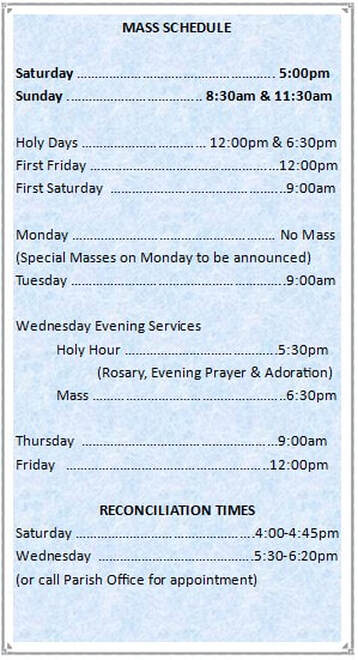For today's Mass Readings click HERE.
|
Saints & Observances
July 1: St. Junipero Serra, Priest July 3: St. Thomas, Apostle July 4: U.S. Independence Day July 5: St. Anthony Zaccaria, Priest; St. Elizabeth of Portugal; First Friday Devotion July 6: St. Maria Goretti, Virgin & Martyr; First Saturday Devotion July 7: Fourteenth Sunday in Ordinary Time (Year B) July 9: St. Augustine Zhao Rong, Priest, and Companions, Martyrs July 11: St. Benedict, Abbot July 13: St. Henry July 14: Fifteenth Sunday in Ordinary Time (Year B) July 15: St. Bonaventure, Bishop & Doctor of the Church July 16: Our Lady of Mount Carmel July 18: St. Camillus de Lellis, Priest July 20: St. Apollinaris, Bishop & Martyr July 21: Sixteenth Sunday in Ordinary Time (Year B) July 22: St. Mary Magdalene July 23: St. Bridget, Religious July 24: St. Sharbel Makhluf, Priest July 25: St. James, Apostle July 26: Sts. Joachim and Anne, Parents of the Blessed Virgin Mary July 28: Seventeenth Sunday in Ordinary Time (Year B) July 29: Sts. Martha, Mary and Lazarus July 30: St. Peter Chrysologus, Bishop & Doctor of the Church July 31: St. Ignatius of Loyola, Priest |
Dedicate a Mass in “Memory” or in “Honor” of a loved one.
Dedication of Masses are limited to two weekend and two Wednesday evening Masses per intention for a particular member. Daily Masses are also available. If you would like to dedicate a Mass in “Memory” or in “Honor” of a loved one, please call the Church Office 425-1590. Whatever moves you to become part of this Mass is what you can donate.
Dedication of Masses are limited to two weekend and two Wednesday evening Masses per intention for a particular member. Daily Masses are also available. If you would like to dedicate a Mass in “Memory” or in “Honor” of a loved one, please call the Church Office 425-1590. Whatever moves you to become part of this Mass is what you can donate.
Mass Intentions at Good Shepherd
Altar FlowersWould you like to purchase flowers for the Altar in Memory or in Honor of a loved one for a weekend? The Flower Sign-up Board is located in the Kitchen airlock. Cost: $50.00
|
Sanctuary LightIf you wish to have the Sanctuary Lamp burning in memory or honor of a loved one, to honor a special occasion, or a special intention, make arrangements with the Parish Office, 425-1590.
|

The Prayer for Vocations
Heavenly Father, Bless your church with an abundance of holy and zealous priests, deacons, brothers and sisters. Give those you have called to the married state and those you have chosen to live as single persons in the world, the special graces that their lives require. Help those who have embraced the consecrated life to live up to their promises. Form us all in the likeness of your Son so that in Him, with Him and through Him we may love you more deeply and serve you more faithfully, always and everywhere. With Mary we ask this through Christ our Lord. Amen.
Heavenly Father, Bless your church with an abundance of holy and zealous priests, deacons, brothers and sisters. Give those you have called to the married state and those you have chosen to live as single persons in the world, the special graces that their lives require. Help those who have embraced the consecrated life to live up to their promises. Form us all in the likeness of your Son so that in Him, with Him and through Him we may love you more deeply and serve you more faithfully, always and everywhere. With Mary we ask this through Christ our Lord. Amen.


